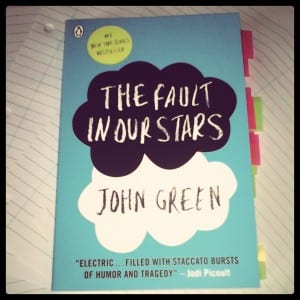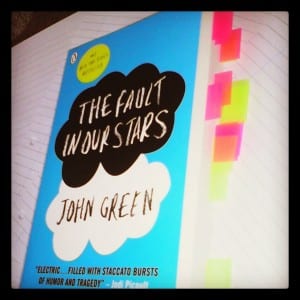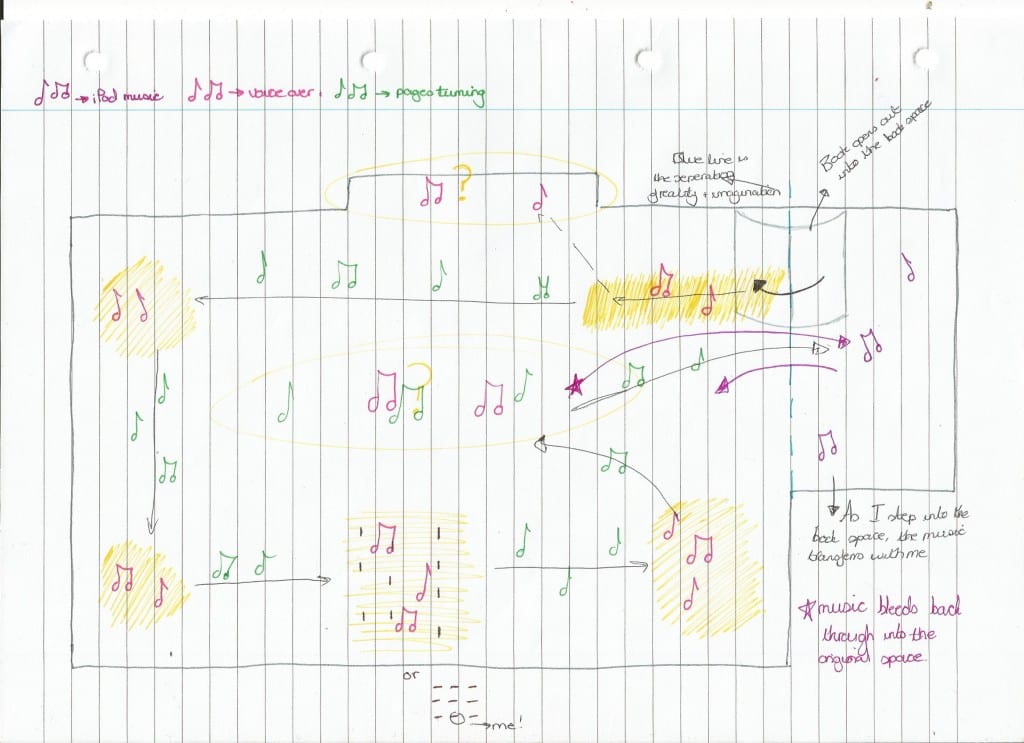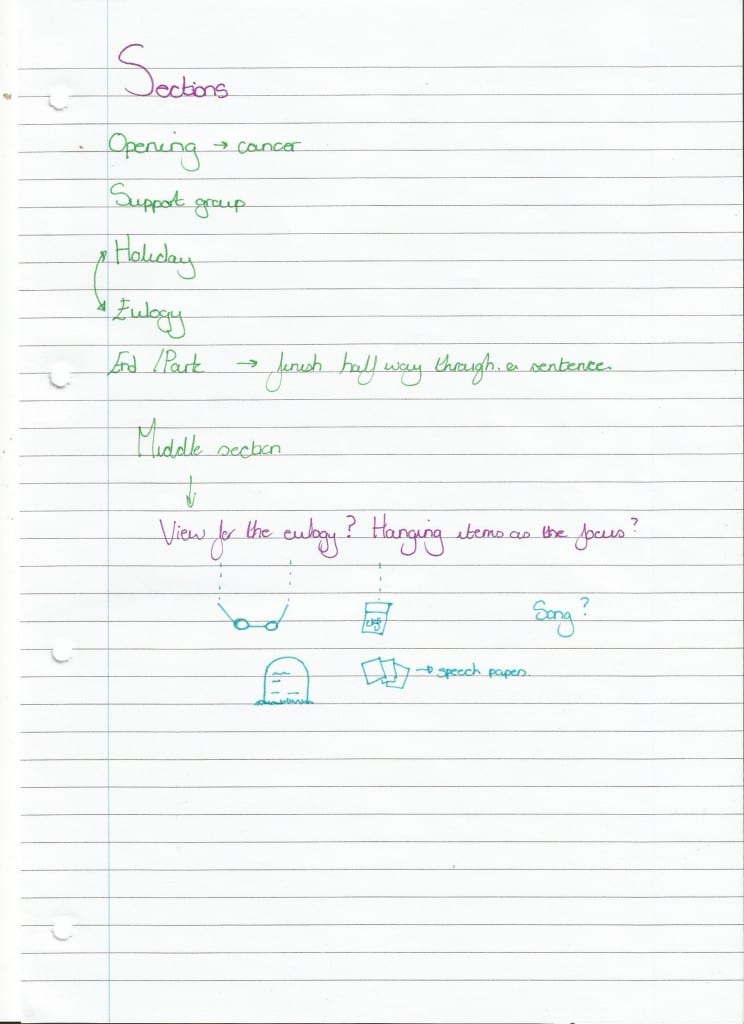Trying to create a space which retains the essence of reading while making it a more immersive event without entering into a ‘circle time’ idea of relaying a story was one of my initial stumbling blocks. I initially looked at such practitioners as Chris Goode, Laurie Anderson and Tim Crouch, and although they all have different outcomes of their story-telling, they are still essentially ‘story-telling’ (albeit breaking the natural connection we have of being told a story). By creating characters or a narrative, these practitioners mix both music and speech to relay their tales. So, rather than personally telling a story live, I want to create a reading atmosphere by using my recorded voice, the use of music, alterations in light and the use of set.
Recorded voice: when a person reads, they read in their own voice – the descriptions and the dialogue. Rather than myself reading aloud, I want to involve audio books. This way the audience can be told a story on a personal level, but rather than hearing it in their own voice, they are hearing it in my head voice.
 |
 |
| Set idea #1 |
Set idea #2 |
Initially I wanted to separate different performance elements. The idea of moving from the real world into a more fictional, personal world.
In idea #1, the space is separated into the real world, a comfortable reading world and an internal world. Moving from the harsh realities of numbers (ISBN numbers), to an idea of an ideal reading world- pillows, blankets, fairy lights- which then contains elements of fiction: hanging cut out images of iconic characters and the opportunity to listen to certain chapters from books. The audience members would then progress into a more internalised space which is centred around a hug book rug which I would be sitting on, reading a book. The space would be lit in a white wash around the space, with colours (pink, yellow, purple, green, orange) which are introduced towards the centre of the space which focus on the rug.
Idea #2
I wanted to see what would happen if I combined all of these elements into a singular space. The elements remain the same; the audio books, the use of colour, the hanging elements and the creation of a comfortable space but the composition of the space would make the piece more immersive, and overall a more active performance. Personally I like the 2nd idea better as it allows the audience more freedom, while also creating a more dynamic space; with the ideas overlapping and crossing each other’s domains it creates a more intelligent space while allowing a more colourful experience for the audience; allowing them to inhabit one space more fully, allowing them to become more comfortable within it, also allowing them more freedom to own the space as much as I will.
Owning the space won’t come through the domination or interruption of the piece, but by the opportunities given to them. There will be books scattered around the book rug, increasing in density the closer to the rug they get. Hopefully with the space created and after being invited to listen to various audio books, alongside me reading, the audience might feel inclined to pick up a book themselves and involve themselves in my space.
Book rug: I want to make a book rug! A massive rug made from materials, bed sheets, even paper, which is big enough for me to sit comfortably within. When you read, you enter a new world, but by using the rug I can literally enter a new space created by a book! As well as aesthetically looking like a book, it will also work like one with pages that turn!
Sarah Lewis is a theatre maker and designer who works primarily creating set, costume and props for the Nottingham Playhouse. Her designs encompass some of the ideas which I hope to create in my final performance; her use of draping and hanging materials/objects, with her unobtrusive use of lighting lends her designs to a feeling of natural growth, one which is welcoming to the audience and almost has a reach beyond the set rules of stage/spectator. Below are a few images taken from her portfolio which lend themselves towards my imagined image (Lewis also works extensively with puppetry, although those ideas will be ignored for the purpose of ‘creating a world’ here).
 |
|
Lewis, Sarah (2011) The Tempest, Online: http://3.bp.blogspot.com/-t4tb0FeMEfU/TvDh3HsG1NI/AAAAAAAAAk8/iUsbqCbtqmg/s1600/TEMPEST+4.jpg [accessed: 1 March 2014].
|
 |
|
Lewis, Sarah (2010) Memory of a Day, Online: http://2.bp.blogspot.com/_d1oG1XYSxOg/TJoTl-eqmCI/AAAAAAAAAH4/gCkcOBHuaKM/s1600/jar+proression.jpg [accessed 1 March 2014].
|
 |
|
Lewis, Sarah (2013) A Thousand Cranes, Online: http://1.bp.blogspot.com/-8eWeQDkriK8/UVQXA89tCZI/AAAAAAAACYY/fr0XOdIBGJo/s1600/thousand+cranes+scale+model.jpg [accessed: 1 March 2014].
|
 |
|
Lewis, Sarah (2010) A Midsummer Night’s Dream, Online: http://2.bp.blogspot.com/_d1oG1XYSxOg/TJoTl-eqmCI/AAAAAAAAAH4/gCkcOBHuaKM/s1600/jar+proression.jpg [accessed: 1 March 2014].
|
|

|
|
Lewis, Sarah (2013) A Thousand Cranes, Online: http://25.media.tumblr.com/3bfebab1ddd44a61e3b6fb60c3994303/tumblr_mnoniiSzo11sn0w0io10_r2_1280.jpg [accessed: 1 March 2014].
|












